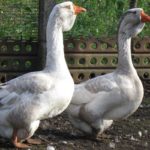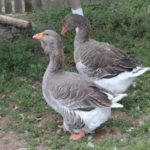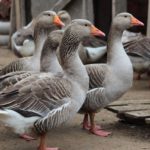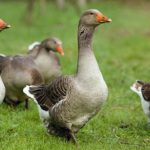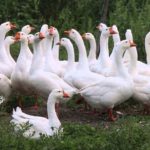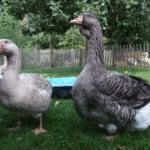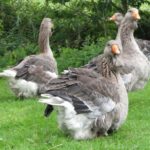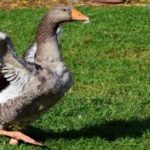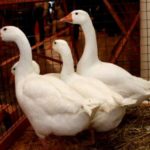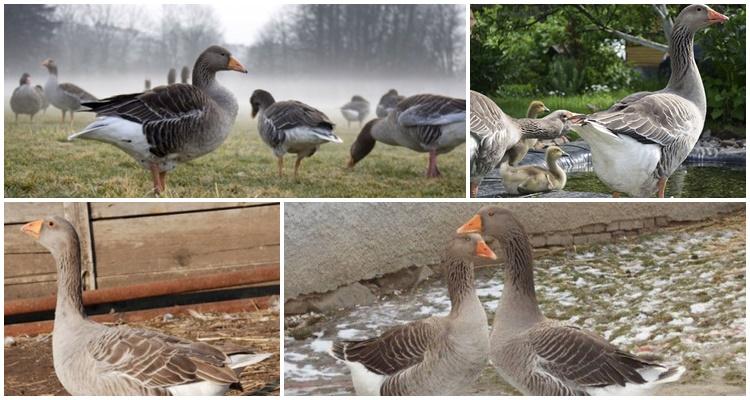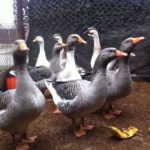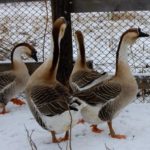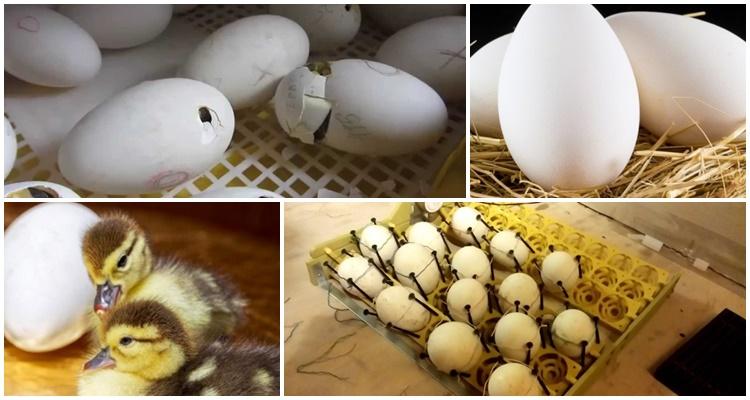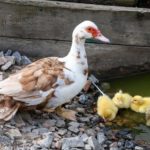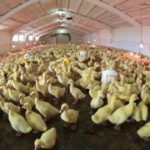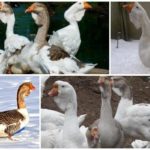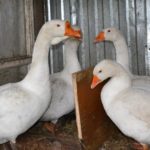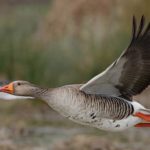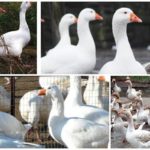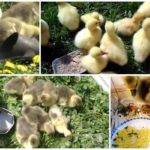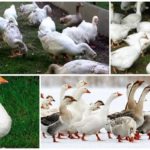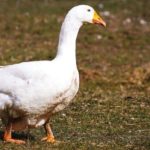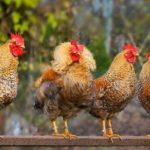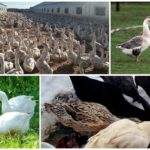Breeding geese is a profitable activity; the bird is smart, can withstand any vagaries of weather, and is unpretentious in feed. Maintenance costs are low, and the yield of goose products is impressive - feathers, fluff, high-tasting meat, healthy fat, liver, which is in demand when preparing gourmet pates. Let's look at the rules for raising geese - housing conditions, choice of breed, breeding methods.
Breed selection
Each breed of geese has pros and cons; beginning poultry farmers need to take them into account when choosing young animals. The following breeds of geese are successfully raised in Russia.
Kholmogorskaya
The breed is bred for meat, the goose grows up to 10-12 kilograms, and at 2 months it weighs 4 kilograms.
The breed is a long-lived goose, living 12-17 years. Geese weigh up to 8 kilograms and often crush eggs.
Large gray
A meat breed of geese, it reaches 4 kilograms already at 9 weeks. The weight of an adult is 7-8 kilograms. They are unpretentious, have good immunity, and can be grown without a pond.
Some poultry farmers note the low survival rate of young animals of this breed.
Lindovskaya
The breed was bred in the Nizhny Novgorod region. You can raise a large bird (3.5-4 kilograms) in 2-3 months; at 5 months the weight is 7 kilograms.
Lindovsky breed of geese produces more than 50 eggs per year, laid mainly from February to July.
Toulouse
Massive geese with a male body weight of 9-11 kilograms.The French breed was bred for tasty meat and an impressively sized liver for making foie gras.
The Toulouse breed produces eggs with a dense shell and weighing 180-200 grams - 18-40 eggs annually.
Basic requirements for keeping geese at home
For novice poultry farmers who are starting breeding from scratch, it is important to familiarize themselves with the basic rules of keeping and feeding. Geese have dense plumage, which helps withstand temperature changes (up to -25 °); the livestock can be kept outdoors almost all year round. Let's take a closer look at the content requirements:
- Geese are able to graze for most of the day. In the village and at the dacha they are kept for walking. The ideal option is grazing near a reservoir. Geese are well oriented and find their way on their own.
- Poultry houses are built from natural materials - wood, brick. Ventilation, protection from drafts, and lighting must be provided. If the contents are seasonal, a canopy is sufficient.
- A paddock is made near the poultry house for walking, even if the geese spend most of the day near the pond.
- Area standards are 1 square meter per adult indoors, 2 meters in the walking area.
- During winter maintenance, the temperature in the poultry house is not allowed to drop below 5 °. Peat bedding helps keep paws from freezing.
- The floor of the poultry house is covered with bedding material - straw, hay, sawdust, peat. The litter is replaced every 7-10 days.
- Recommended humidity is 60-70%.With high rates, geese often catch colds and get sick.
- The nests are placed in the far part of the poultry house or shed. They are made from boxes, plywood, baskets, and softened with bedding. One nest is enough for 2-3 geese.
The farm needs to have drinking bowls and feeders. You can water geese from any heavy metal utensils, which are placed on pallets to prevent them from spreading on the floor or ground. When choosing feeders, take into account the type of food and the fact that all the geese eat at the same time.
Rules for caring for birds
Most poultry farmers keep geese seasonally - they purchase goslings, raise them to the required condition and slaughter them. Keeping a bird for longer than 6 months is not advisable. The meat becomes coarser and loses its taste and nutritional qualities. Let's look at how to care for young and adult birds:
- Goslings are purchased at least 5 days old. 2-3 week old goslings can be raised immediately on a range near the poultry house in a fenced area; they are more expensive, but the survival rate is higher.
- It is important to observe the temperature regime - the first days the goslings need 26-28 °. Lighting is regulated, lamps are used to extend daylight hours to 16-18 hours.
- Depending on the breed, planting standards are chosen. Large breeds - 4-6 goslings per square meter, small breeds - 6-8 individuals.
- Overcrowding is dangerous for young animals - the goslings crush each other, they do not have enough air. Weakened goslings do not get food.
- For heating, use a heating pad, bottles of warm water, and infrared lamps.
- They try not to disturb the young animals too much; they change the bedding carefully, from the edge.
- Geese can train young animals to walk, and the goslings willingly follow them. If there is no adult bird, at 2-3 weeks the small geese are carefully directed to a fenced area.
- For young animals, low feeders are used (height - 2-3 centimeters). For older geese, long troughs are made so that each is 15 centimeters long.
- Weak goslings are fed separately, making sure that they get food and a comfortable place.
If you plan to raise geese without a pond or free range, you need to be prepared to consume more feed, use vitamins, and premixes to support immunity.
What to feed?
When kept on pasture, geese eat grass, algae, and other pasture. In farms without free range, poultry can be raised on different feeding rations:
- dry – used on poultry farms, consisting of mixed feed and dry mixtures;
- combined - combine feed, greens, mash, household waste.
In summer, geese are fed twice; during the day, the bird obtains food itself. When preparing the diet, combine roughage and succulent feed. Hay improves peristalsis and is included in the winter diet daily.
The following types of feed are used for feeding at home:
- grains – barley, corn, wheat, oats, including sprouted ones;
- herbs, foliage of trees and shrubs, berries (rowan, rosehip);
- bran, cake;
- bone, fish meal;
- chopped vegetables and root vegetables - pumpkin, zucchini, carrots.
To increase fatness before slaughter and during mating, the ganders’ norms are increased and protein-vitamin mixtures are introduced into the diet. In the first days of life, goslings are fed eggs, cottage cheese, and cereals 5-6 times a day. From 10 days they give flour mixtures and herbs (alfalfa, clover).Be sure to introduce feed containing proteins (bone meal, meat meal), as well as yeast, chalk, and salt. In adult birds and goslings, the water in the drinking bowls is constantly monitored. In the cold season, water is provided heated. Geese drink a lot, especially in the heat.
Note: the taste of goose meat depends on the composition and quality of the feed.
Breeding methods
During the breeding season, the number of eggs increases, the ganders become aggressive, and often fight. When breeding 3 geese, they usually keep one male. In most breeds of geese, females have developed maternal feelings and are able to hatch clutches themselves. The goslings hatch on the 28th day.
Incubator
Incubation is used if it is impossible to place the goose on eggs. During incubation, it is possible to obtain an offspring from only 70% of the eggs. Rules for breeding geese in an incubator:
- with the beginning of the active breeding season, eggs are selected - within 10 days, the best (large, even, without defects);
- eggs are treated with a weak solution of potassium permanganate;
- prepare the incubator - set the temperature to 40 ° for 4 hours;
- The laid eggs are kept at a temperature of 38 ° for 5 hours, then set to 37.5 °;
- turn the masonry over 6-8 times daily;
- Once every 2 weeks, ventilate the incubator for 10 minutes.
An incubator is usually used when raising broiler breeds.
Breeding chicks by a hen
Females begin laying eggs at 8-10 months. Laying geese are usually kept for 4-6 years, males per breed for 8 years. Since the size of the eggs is significant, the clutch consists of 13-14 pieces. To breed goslings naturally (by hatching), follow the following rules:
- the nest is located in a secluded place in the house (in the far corner);
- other birds are not allowed to the nest, so that extraneous females do not lay their eggs in the clutch during incubation;
- the room and nest are kept warm (14-16 °), protected from moisture, drafts, and do not disturb the goose;
- damaged eggs are removed from the nest;
- the goose is given selected food and the water is changed regularly;
- make sure that the bird does not abandon the clutch for more than 20 minutes.
The emerging goslings are collected in a box lined with a warm cloth and heated with a lamp. When all have hatched, the little goslings are returned to their mother to be raised.
Possible diseases and prevention from them
The most common diseases in different breeds of geese include:
- infections – pasteurellosis, paratyphoid fever, colibacillosis;
- invasive – coccidiosis;
- helminthiases – infection with parasites;
- hypovitaminosis.
In the cold season and with excess humidity, geese can catch colds and suffer from viral and bacterial infections with sinusitis. Prevention includes:
- carrying out vaccinations against common infections;
- maintaining the cleanliness of the poultry house, walking areas, and equipment;
- disinfection of premises every 6 months;
- a balanced diet to prevent hypovitaminosis;
- replacing litter every 7-10 days;
- monitoring the condition of reservoirs;
- deworming.
Sick geese are isolated and quarantine measures are carried out. Breeding geese provides reliable income and provides the family with delicious meat. Other products from goose farms - down, feathers, fat - are also in demand on the market. Geese of all breeds have good immunity, are able to find food, stay in a flock, return safely from walking, and do not require much care or expense when keeping them.


